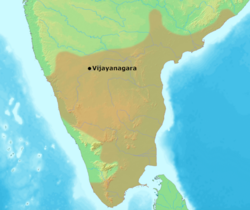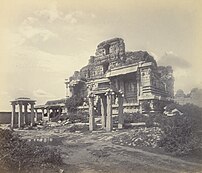
Back إمبراطورية فيجاياناغارا Arabic Imperiu vijayanagara AST Vicayanaqar imperiyası Azerbaijani ویجایاناقار ایمپیراتورلوغو AZB Віджаянагарская імперыя Byelorussian Виджаянагара (империя) Bulgarian বিজয়নগর সাম্রাজ্য Bengali/Bangla Imperi de Vijayanagara Catalan Vidžajanagarská říše Czech Vijayanagar-kongeriget Danish
Vijayanagara Empire | |||||||||||||||||||||
|---|---|---|---|---|---|---|---|---|---|---|---|---|---|---|---|---|---|---|---|---|---|
| 1336–1646[1] | |||||||||||||||||||||
 The Vijayanagara Empire in 1485, tributaries not shown | |||||||||||||||||||||
| Capital | Vijayanagara (1336–1565) Penukonda (1565–1592) Chandragiri (1592–1604) Vellore (1604–1646)[2] | ||||||||||||||||||||
| Common languages | Kannada Sanskrit Telugu[3] | ||||||||||||||||||||
| Religion | Hinduism | ||||||||||||||||||||
| Government | Monarchy | ||||||||||||||||||||
| Emperor | |||||||||||||||||||||
• 1336–1356 | Harihara I (first) | ||||||||||||||||||||
• 1356–1377 | Bukka Raya I | ||||||||||||||||||||
• 1423–1446 | Deva Raya II | ||||||||||||||||||||
• 1509–1529 | Krishna Deva Raya | ||||||||||||||||||||
• 1529–1542 | Achyuta Deva Raya | ||||||||||||||||||||
• 1642–1646 | Sriranga III (last) | ||||||||||||||||||||
| History | |||||||||||||||||||||
• Established | 18 April 1336 | ||||||||||||||||||||
• Earliest records | 1343 | ||||||||||||||||||||
| 23 January 1565 | |||||||||||||||||||||
• Disestablished | 1646[1] | ||||||||||||||||||||
| Population | |||||||||||||||||||||
• 1500 estimate | 18,000,000[4] | ||||||||||||||||||||
| Currency | Varaha | ||||||||||||||||||||
| |||||||||||||||||||||
| Today part of | India | ||||||||||||||||||||
The Vijayanagara Empire (/vɪˌdʒəjəˈnəɡərə/; also known as the Karnata Kingdom) was a late medieval Hindu empire that ruled much of southern India. It was established in 1336 by the brothers Harihara I and Bukka Raya I of the Sangama dynasty, belonging to the Yadava clan of Chandravamsa lineage.[5][6][a]
The empire rose to prominence as a culmination of attempts by the southern powers to ward off Muslim invasions by the end of the 13th century. At its peak in the early 16th century under Krishnadevaraya, it subjugated almost all of Southern India's ruling dynasties and pushed the Deccan sultanates beyond the Tungabhadra-Krishna River doab region, in addition to annexing the Gajapati Empire (Odisha) up to the Krishna River, becoming one of the most prominent states in India.[7] The empire's territory covered most of the lands of the modern-day Indian states of Karnataka, Andhra Pradesh, Tamil Nadu, Kerala, Goa, and some parts of Telangana and Maharashtra.[8]
The empire lasted until 1646, although its power declined greatly after a major military defeat in the Battle of Talikota in 1565 by the combined armies of the Deccan sultanates. The empire is named after its capital city of Vijayanagara (modern-day Hampi) whose extensive ruins are now a UNESCO World Heritage Site in Karnataka. The wealth and fame of the empire inspired visits by and writings of medieval European travelers such as Domingo Paes, Fernão Nunes, and Nicolò de' Conti. These travelogues, contemporary literature and epigraphy in the local languages, and modern archeological excavations at Vijayanagara have provided ample information about the history and power of the empire.
The empire's legacy includes monuments spread over Southern India, the best known of which is the group at Hampi. Different temple building traditions in South and Central India were merged into the Vijayanagara architectural style. This synthesis inspired architectural innovations in the construction of Hindu temples. Efficient administration and vigorous overseas trade brought new technologies to the region such as water management systems for irrigation. The empire's patronage enabled fine arts and literature to reach new heights in Kannada, Telugu, Tamil, and Sanskrit with topics such as astronomy, mathematics, medicine, fiction, musicology, historiography and theater gaining popularity. The classical music of Southern India, Carnatic music, evolved into its current form. The Vijayanagara Empire created an epoch in the history of Southern India that transcended regionalism by promoting Hinduism as an unifying factor.
| Vijayanagara Empire |
|---|
| Ruling dynasties |
- ^ Reddy, P. Bhaskar. "The Vijayanagara Empire".
- ^ Howes, Jennifer (1998). The Courts of Pre-colonial South India: Material Culture and Kingship. Psychology Press. p. 43. ISBN 978-07-0071-585-5.
- ^ Bridges, Elizabeth J. (2016). "Vijayanagara Empire". In Dalziel, N.; MacKenzie, J. M. (eds.). The Encyclopedia of Empire. pp. 1–5. doi:10.1002/9781118455074.wbeoe424. ISBN 978-1118455074.
- ^ Alexander V Avakov (April 2015). Globalising Migration History: The Eurasian Experience (16th–21st Centuries. Algora. p. 101. ISBN 978-1-628-94101-2. Retrieved 28 July 2016.
- ^ Dhere 2011, p. 243.
- ^ Sewell 2011, pp. 22, 23, 420.
- ^ Stein 1989, p. xi.
- ^ "Vijayanagar | Ancient City & Empire, India | Britannica". www.britannica.com. 13 October 2024. Retrieved 30 October 2024.
Cite error: There are <ref group=lower-alpha> tags or {{efn}} templates on this page, but the references will not show without a {{reflist|group=lower-alpha}} template or {{notelist}} template (see the help page).



